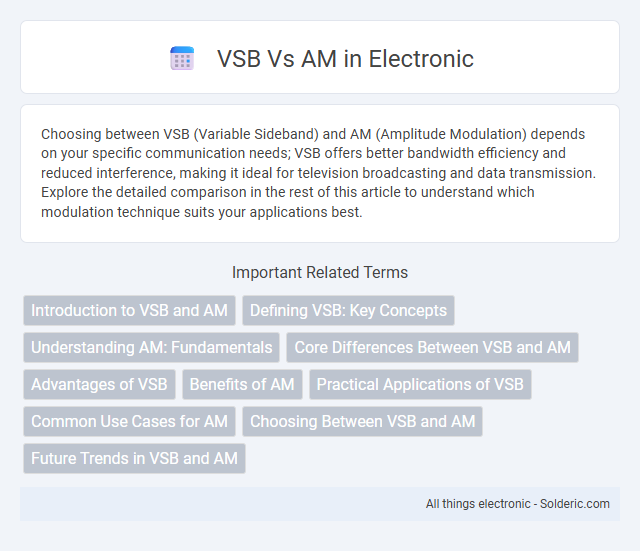Choosing between VSB (Variable Sideband) and AM (Amplitude Modulation) depends on your specific communication needs; VSB offers better bandwidth efficiency and reduced interference, making it ideal for television broadcasting and data transmission. Explore the detailed comparison in the rest of this article to understand which modulation technique suits your applications best.
Comparison Table
| Feature | VSB (Variable Sideband) | AM (Amplitude Modulation) |
|---|---|---|
| Definition | Modulation technique with adjustable sideband width | Modulation by varying signal amplitude |
| Bandwidth | Less than AM; narrower than double sideband | Double the baseband signal bandwidth |
| Power Efficiency | Higher than AM due to reduced bandwidth | Lower; power spread across carrier and sidebands |
| Complexity | Moderate; requires special filtering | Simple; straightforward modulation/demodulation |
| Applications | TV broadcasting, specialized communication | AM radio, basic communication systems |
| Signal Quality | Improved spectral efficiency, less interference | More noise prone, less spectral efficiency |
Introduction to VSB and AM
Vestigial Sideband (VSB) and Amplitude Modulation (AM) are modulation techniques used in communication systems to transmit information over carrier waves. AM transmits the entire amplitude variations of the carrier wave, including both upper and lower sidebands, resulting in wider bandwidth usage. VSB, a variant of AM, reduces bandwidth by partially suppressing one sideband, offering a balance between bandwidth efficiency and signal complexity ideal for television broadcasting and other applications.
Defining VSB: Key Concepts
VSB, or Vestigial Sideband, is a modulation technique that transmits a partial sideband along with a reduced carrier to preserve signal information efficiently. It combines the bandwidth-saving advantages of single sideband (SSB) with the simpler demodulation process of amplitude modulation (AM). Understanding VSB's key concept helps optimize communication systems where spectral efficiency and signal integrity are crucial for your transmission needs.
Understanding AM: Fundamentals
Amplitude Modulation (AM) involves varying the amplitude of a carrier wave in direct proportion to the instantaneous value of the baseband signal, allowing transmission of audio or data over radio frequencies. Understanding AM fundamentals includes recognizing its bandwidth requirement, which is twice the highest frequency of the modulating signal, and its susceptibility to noise and signal fading due to amplitude variations. Unlike AM, Vestigial Sideband (VSB) modulation transmits one full sideband and a partial sideband, optimizing bandwidth usage while maintaining signal integrity.
Core Differences Between VSB and AM
VSB (Vestigial Sideband) reduces bandwidth by partially suppressing one sideband, making it more bandwidth-efficient than traditional AM (Amplitude Modulation), which transmits both sidebands and the carrier. VSB is commonly used in television broadcasting to balance spectrum efficiency and signal quality, while AM is mainly utilized in radio transmissions for its simplicity and coverage. The key difference lies in VSB's selective sideband filtering that minimizes bandwidth without sacrificing signal integrity, contrasting with AM's full-bandwidth transmission.
Advantages of VSB
Vestigial Sideband (VSB) modulation offers a key advantage in bandwidth efficiency, requiring less spectrum than traditional double sideband AM yet retaining essential carrier components for easier demodulation. This modulation technique enables improved signal quality and reduced power consumption compared to AM, making it ideal for television broadcasting and long-distance communication. VSB's balance of bandwidth economy and signal fidelity enhances overall transmission efficiency while minimizing interference and noise.
Benefits of AM
Additive manufacturing (AM) offers significant benefits over traditional vacuum suction brazing (VSB), including enhanced design flexibility that allows for complex geometries impossible with conventional methods. AM reduces material waste through precise layer-by-layer construction, leading to cost savings and sustainability advantages. Additionally, AM accelerates prototyping and production times by eliminating tooling requirements, fostering rapid innovation and customization.
Practical Applications of VSB
VSB (Vestigial Sideband) modulation is widely utilized in broadcast communications such as television transmissions, where bandwidth efficiency and quality signal recovery are crucial. Its ability to reduce bandwidth while preserving information makes it ideal for TV audio and video signals over AM (Amplitude Modulation). You benefit from improved spectrum utilization and enhanced signal clarity in practical scenarios like analog TV broadcasting.
Common Use Cases for AM
Amplitude Modulation (AM) is commonly used in long-range AM radio broadcasting and aviation communications due to its simplicity and effectiveness over large distances. Vestigial Sideband (VSB), on the other hand, is favored in television broadcasting and digital transmissions where bandwidth efficiency and partial sideband suppression are critical. Understanding these differences helps you choose the right modulation technique for applications requiring either wide coverage or optimized spectral use.
Choosing Between VSB and AM
Choosing between Vestigial Sideband (VSB) and Amplitude Modulation (AM) depends on your bandwidth efficiency and signal quality needs. VSB offers reduced bandwidth usage compared to conventional AM while maintaining compatibility with standard AM receivers, making it ideal for television broadcasts and data transmission. Your choice should consider VSB's superior spectral efficiency against AM's simplicity and broader availability in legacy systems.
Future Trends in VSB and AM
Future trends in Vestigial Sideband (VSB) and Amplitude Modulation (AM) emphasize the integration of digital technologies and enhanced spectral efficiency. VSB modulation is increasingly adopted in digital television broadcasting due to its balance between bandwidth utilization and signal robustness, while AM continues to evolve with hybrid digital-AM systems improving audio quality and interference resistance. Your communication infrastructure can benefit from upcoming advancements that leverage these techniques to support higher data rates and improved signal reliability in diverse transmission environments.
VSB vs AM Infographic

 solderic.com
solderic.com